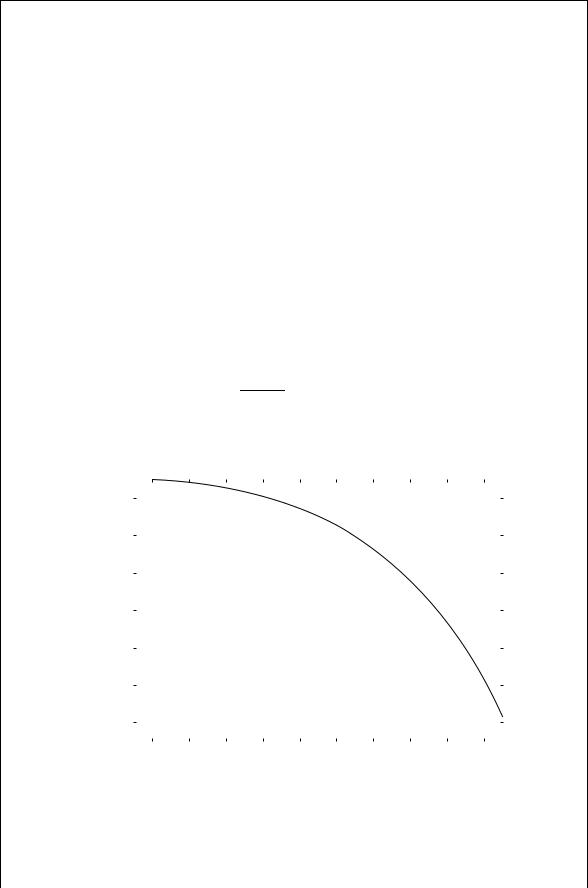
06.Transmission line transformers
.pdf
Radio Frequency Circuit Design. W. Alan Davis, Krishna Agarwal
Copyright 2001 John Wiley & Sons, Inc.
Print ISBN 0-471-35052-4 Electronic ISBN 0-471-20068-9
CHAPTER SIX
Transmission Line Transformers
6.1INTRODUCTION
The subject matter of Chapter 3 was impedance transformation. This subject is taken up here again, but now with more careful attention given to the special problems and solutions required for RF frequency designs. The discrete element designs described previously can be used in RF designs with the understanding that element values will change as frequency changes. The alternative to discrete element circuits are transmission line circuits. The classical microwave quarter wavelength transformer can be used up to hundreds of GHz in the appropriate transmission line medium. However, at 1 GHz, a three-section quarter wavelength transformer would be a little less than a meter long! The solution lies in finding a transformation structure that may not work at 100 GHz but will be practical at 1 GHz.
The conventional transformer consists of two windings on a high-permeability iron core. The flux, , is induced onto the core by the primary winding. By Faraday’s law the secondary voltage is proportional to d /dt. For low-loss materials, the primary and secondary voltages will be in phase. Ideal Transformers have perfect coupling and no losses. The primary-to-secondary voltage ratio is equal to the turns ratio, n, between the primary and secondary windings, namely Vp/Vs D n. The ratio of the primary to secondary current is Ip/Is D 1/n. This implies conservation of power, VpIp D VsIs. As a consequence the impedance seen by the generator or primary side in terms of the load impedance is
ZG D n2ZL
When the secondary side of the ideal transformer is an open circuit, the input impedance of the transformer on the primary side is 1.
In a physical transformer the ratio of the leakage inductances on primary and secondary sides is Lp/Ls D n. For the ideal transformer, Lp and Ls approach
105

106 TRANSMISSION LINE TRANSFORMERS
1, but their ratio remains finite at Lp/Ls D n. The physical transformer has an
associated mutual inductance, M D k LpLs, where k is the coupling coefficient. The leakage inductance together with the interwire capacitances limits the highfrequency response. The transmission line transformer avoids these frequency limitations.
6.2IDEAL TRANSMISSION LINE TRANSFORMERS
It was found earlier, in Chapter 2, that inductive coils always come with stray capacitance. It was this capacitance that restricted the frequency range for a standard coupled coil transformer. The transmission line transformer can be thought of as simply tipping the coupled coil transformer on its side. The coil inductance and stray capacitance now form the components for an artificial transmission line whose characteristic impedance is
Z0 |
D |
|
|
L |
|
6.1 |
|
C |
|||||
|
|
|
|
|||
The transmission line can be used, in principle, up to very high frequencies, and in effect it reduces the deleterious effects of the parasitic capacitance. The transmission line transformer can be made from a variety of forms of transmission lines such as a two parallel lines, a twisted pair of lines, a coaxial cable, or a pair of wires on a ferrite core. The transmission line transformer can be defined as having the following characteristics:
1.The transmission line transformer is made up of interconnected lines whose characteristic impedance is a function of such mechanical things as wire diameter, wire spacing, and insulation dielectric constant.
2.The transmission lines are designed to suppress even mode currents and allow only odd-mode currents to flow (Fig. 6.1).
3.The transmission lines carry their own “ground,” so transmission lines relative to true ground are unintentional.
4.All transmission lines are of equal length and typically < /8.
5.The transmission lines are connected at their ends only.
6.Two different transmission lines are not coupled together by either capacitance or inductance.
io |
ie |
io |
ie |
|
|
FIGURE 6.1 A two-wire transmission line showing the oddand even-mode currents.

IDEAL TRANSMISSION LINE TRANSFORMERS |
107 |
7.For a short transmission line, the voltage difference between the terminals at the input port is the same as the voltage difference at the output port.
Some explanation of these points is needed to clarify the characteristics of the transmission line transformer. In property 2, for a standard transmission line the current going to the right must be equal to the current going to the left in order to preserve current continuity (Fig. 6.1). Since only odd-mode currents are allowed, the external magnetic fields are negligible. The net current driving the magnetic field outside of the transmission line is low. The third point is implied by the second. The transmission line is isolated from other lines as well as the ground. The equality of the odd mode currents in the two lines of the transmission line as well as the equivalence of the voltages across each end of the transmission line is dependent on the transmission line being electrically short in length. The analysis of transmission line transformers will be based on the given assumptions above.
As an example consider the transmission line transformer consisting of one transmission line with two conductors connected as shown in Fig. 6.2. The transformation ratio will be found for this connection. Assume first that v1 is the voltage across RG and i1 is the current leaving the generator resistance:
1.i1 is the current through the upper conductor of the transmission line.
2.The odd-mode current i1 flows in the opposite direction in the lower conductor of the transmission line.
3.The sum of the two transmission line currents at the output node is 2i1.
4.The voltage at the output node is assumed to be vo. Consequently the voltage at left side of the lower conductor in the transmission line is vo above ground.
5.On the left-hand side, the voltage difference between the two conductors is v1 vo.
|
1 i1 |
5 |
2i1 3 |
|
v1 |
vo |
|
RG |
4 vo |
0 |
i1 |
i1 |
2 |
RL |
|
|
|
FIGURE 6.2 Analysis steps for a transmission line transformer.

108 TRANSMISSION LINE TRANSFORMERS
This is the same voltage difference on the right hand side. Consequently,
vo 0 D v1 vo
vo D v1
2
If RG D v1/i1, then
RL D |
vo |
D |
v1/2 |
D |
RG |
6.2 |
2i1 |
2i1 |
4 |
This 4 : 1 circuit steps down the impedance level by a factor of 4.
A physical connection for this transformer is shown in Fig. 6.3 where the transmission line is represented as a pair of lines. In this diagram the nodes in the physical representation are matched to the corresponding nodes of the formal representation. The transmission line is bent around to make the B–C distance a short length. The transmission line, shown here as a two-wire line, can take a variety of forms such as coupled line around a ferromagnetic core, flexible microstrip line, or coaxial line. If the transformer is rotated about a vertical axis at the center, the circuit shown in Fig. 6.4 results. Obviously this results in a 1 : 4 transformer where RL D 4RG. Similar analysis to that given above verifies this result. In addition multiple two-wire transmission line transformers may be tied together to achieve a variety of different transformation ratios. An example of three sections connected together is shown in Fig. 6.5. In this circuit the current from the generator splits into four currents going into the transmission lines. Because of the equivalence of the odd-mode currents in each line, these four currents are all equal. The voltages on the load side of each line pair build up from ground to 4 ð the input voltage. As a result, for match to occur, RL D 16RG.
The voltages and currents for a transmission line transformer (TLT) having a wide variety of different interconnections and numbers of transmission lines can
|
A |
C |
|
B |
|
B |
|
|
A |
C |
|
|
|
D |
|
D |
|
(a) |
|
(b) |
FIGURE 6.3 A physical two-wire transmission line transformer and the equivalent formal representation.

IDEAL TRANSMISSION LINE TRANSFORMERS |
109 |
|
|
|
|
|
|
|
RG |
RL |
FIGURE 6.4 An alternate transmission line transformer connection.
RG RL
FIGURE 6.5 A 16 : 1 transmission line transformer.
|
xV |
yV |
|
|
|
||
|
|
TLT |
|
|
yI |
xI |
|
|
|
|
|
|
|
|
|
FIGURE 6.6 Symbol for general transmission line transformer.
be represented by the simple diagram in Fig. 6.6 where x and y are integers. The impedance ratios, RG D x/y2RL, range from 1 : 1 for a one-transmission line circuit to 1 : 25 for a four-transmission line circuit with a total of 16 different transformation ratios [1]. A variety of transmission line transformer circuits are found in [1] and [2].

110 TRANSMISSION LINE TRANSFORMERS
6.3TRANSMISSION LINE TRANSFORMER SYNTHESIS
All the transmission lines in the transmission line transformer shown in Fig. 6.5 have their left-hand sides near the generator connected in parallel and all their right-hand sides near the load connected in series. In this particular circuit there are three transmission lines, and analysis shows that Vin : Vout D 1 : 4, and RG : RL D 1 : 16. The number of transmission lines, m, is the order of the transformer, so that when all the transmission lines on the generator side are connected in shunt and on the load side in series, the voltage ratio is Vin : Vout D 1 : m C 1 . Synthesis of impedance transformations of 1 : 4, 1 : 9, 1 : 16, 1 : 25, and so on, are all obvious extensions of the transformer shown in Fig. 6.5. The allowed voltage ratios, which upon being squared, gives the impedance ratios as shown in Table 6.1. To obtain a voltage ratio that is not of the form 1 : m C 1 , there is a simple synthesis technique [3]. The voltage ratio is Vin : Vout D H : L, where H is the high value and L the low value. This ratio is decomposed into an Vin : Vout D H L : L. If now H L < L, this procedure is repeated where H0 D L and L0 D H L. This ratio is now Vout : Vin, which in turn can be decomposed into H0 L0 : L0. These steps are repeated until a 1 : 1 ratio is achieved, all along keeping track which ratio that is being done, Vin : Vout or Vout : Vin.
An example given in [3] illustrates the procedure. If an impedance ratio of RG : RL D 9 : 25 is desired, the corresponding voltage ratio is Vin : Vout D 3 : 5
Step 1 H : L D Vout : Vin D 5 : 3 ! 5 3 : 3 D 2 : 3
Step 2 H : L D Vin : Vout D 3 : 2 ! 3 2 : 2 D 1 : 2
Step 3 H : L D Vout : Vin D 2 : 1 ! 2 1 : 1 D 1 : 1
Now working backward from step 3, a Vin : Vout D 1 : 2 transmission line transformer is made by connecting two transmission lines in shunt on the input side and series connection on the output side (Fig. 6.7a). From step 2, the Vout is already 2, so another transmission line is attached to the first pair in shunt on the output side and series on the input side (Fig. 6.7b). Finally from step 1, Vin D 3
TABLE 6.1 Voltage Ratios for Transmission Line
Transformers
Number of Lines 1 |
2 |
3 |
4 |
|
|
|
|
1 : 1 |
2 : 3 |
3 : 4 |
4 : 5 |
1 : 2 |
1 : 2 |
3 : 5 |
5 : 7 |
— |
1 : 3 |
2 : 5 |
5 : 8 |
— |
— |
1 : 4 |
4 : 7 |
— |
— |
— |
3 : 7 |
— |
— |
— |
3 : 8 |
— |
— |
— |
2 : 7 |
— |
— |
— |
1 : 5 |
|
|
|
|

+
1V
–
+
3V
–
+
3V
–
|
|
|
ELECTRICALLY LONG TRANSMISSION LINE TRANSFORMERS |
111 |
|||||||||||
|
|
|
|
|
|
|
|
|
|
|
|
|
|
|
|
|
|
|
|
|
|
|
|
|
|
|
|
|
|
|
|
|
|
|
|
+ |
|
|
|
|
|
|
|
||||
|
|
|
|
|
|
|
|
|
|
|
|
|
|
|
|
|
|
|
|
|
|
|
|
2V |
= |
|
1V |
2V |
|
|
|
|
|
|
|
|
|
|
|
|
|
|
|||||
|
|
|
|
|
|
|
|
|
2I |
1I |
|
|
|||
|
|
|
|
|
|
|
|
|
|
|
|
|
|
||
|
|
|
|
|
|
|
|
– |
|
|
|
|
|
|
|
|
|
|
|
|
|
|
|
(a) |
|
|
|
||||
|
|
|
|
|
|
|
|
|
|
|
|
|
|||
|
|
|
|
|
|
|
|
|
|
|
|
|
|||
|
|
|
|
|
|
|
|
|
|
|
|
|
|
|
|
|
|
|
|
|
|
|
|
|
|
|
|
|
|
|
|
|
|
|
|
|
|
+ |
|
|
|
|
|
|
|
||
|
|
|
|
|
|
|
|
|
|
|
|||||
|
|
|
|
|
|
|
|
|
|
|
|
|
|
|
|
|
|
|
|
|
|
|
|
|
|
|
|
|
|
|
|
|
|
|
|
|
|
|
|
2V |
= |
|
3V |
2V |
|
|
|
|
|
|
|
|
|
|
|
|
2I |
3I |
|
|
|||
|
|
|
|
|
|
|
|
|
|
|
|
|
|
||
|
|
|
|
|
|
|
|
|
|
|
|
|
|
|
|
|
|
1V |
2V |
|
|
|
|
– |
|
|
|
|
|
|
|
|
|
2I |
1I |
|
|
|
|
|
|
|
|
|
|
||
|
|
|
|
|
|
|
|
|
|
|
|
|
|
||
|
|
|
|
|
|
|
|
|
|
(b) |
|
|
|
||
|
|
|
|
|
|
|
|
|
|
|
|
|
|||
|
|
|
|
|
|
|
|
|
|
|
|
||||
|
|
|
|
|
|
|
|
|
|
|
|
||||
|
|
|
|
+ |
|
|
|
|
|
|
|
||||
|
|
|
|
|
|
|
|
|
|
|
|
|
|
|
|
|
|
|
|
|
|
|
|
|
|
|
|
|
|
|
|
|
|
|
|
|
|
|
|
5V |
= |
|
3V |
5V |
|
|
|
|
|
|
|
|
|
|
|
|
5I |
3I |
|
|
|||
|
|
|
|
|
|
|
|
|
|
|
|
|
|
||
|
|
|
|
|
|
|
|
|
|
|
|
|
|
|
|
|
|
3V |
2V |
|
|
|
|
– |
|
|
|
|
|
|
|
|
|
2I |
3I |
|
|
|
|
|
|
|
|
|
|
||
|
|
|
|
|
|
|
|
|
|
|
|
|
|
||
|
|
|
|
|
|
|
|
|
|
|
|
|
|
|
|
(c)
FIGURE 6.7 Step-by-step procedure for synthesis for a desired impedance ratio.
already, so the input is connected in shunt with the another added transmission line and the outputs connected in series (Fig. 6.7c). The final design has Vin : Vout D 3 : 5 as desired.
6.4ELECTRICALLY LONG TRANSMISSION LINE TRANSFORMERS
One of the assumptions given in the previous section was that the electrical length of the transmission lines was short. Because of this the voltages and currents at each end of an individual line could be said to be equal. However, as the the line becomes electrically longer (or the frequency increases), this assumption ceases to be accurate. It is the point of this section to provide a means of determining the amount of error in this assumption. Individual design goals would dictate whether a full frequency domain analysis is needed.
As was pointed out in Chapter 4, the total voltage and current on a transmission line are each expressed as a combination of the forward and backward terms (Fig. 6.8). In this case let V2 and I2 represent the voltage and current at the load

112 TRANSMISSION LINE TRANSFORMERS
I 1 |
|
I 2 |
+ |
|
+ |
V1 |
Z 0 |
V 2 |
–
 –
–
FIGURE 6.8 An electrically long transmission line.
end, where VC and V are the forwardand backward-traveling voltage waves:
V2 D VC C V |
6.2 |
|||
I2 D |
VC |
|
V |
6.3 |
Z0 |
Z0 |
|||
Assuming that the transmission line is lossless, the voltage and current waves at the input side, 1, are modified by the phase associated with the electrical length of the line:
V1 D VCej C V e j |
6.4 |
||||
|
VC |
|
V |
|
|
I1 D |
|
ej |
|
e j |
6.5 |
Z0 |
Z0 |
||||
The sign associated with the phase angle, C , for VC is used because the reference is at port 2 while a positive phase is associated with traveling from left to right. The Euler formula is used in converting the exponentials to sines and cosines. The voltage at the input, V1, is found in terms of V2 and I2 with the help of Eqs. (6.2) and (6.3):
V1 D V2 cos C jZ0I2 sin |
6.6 |
Similarly I1 can be expressed in terms of the voltage and current at port 2:
V2 |
|
|
I1 D I2 cos C j Z0 |
sin |
6.7 |
The 1 : 4 transmission line transformer shown in Fig. 6.4 is now reconsidered in Fig. 6.9 to determine its frequency response. The generator voltage can be expressed in terms of the transmission line voltages and currents:
Vg D I1 C I2 RG C V1 |
6.8 |
The nontransmission line connections are electrically short. Therefore the output voltage across RL is Vo D V1 C V2, and
Vg D I1 C I2 RG C I2RL V2 |
6.9 |

|
|
|
|
|
|
|
|
ELECTRICALLY LONG TRANSMISSION LINE TRANSFORMERS |
113 |
|||||||||||||||||||||||
|
|
|
|
|
|
|
|
|
|
|
|
|
|
|
|
|
|
|
|
|
|
|
|
|||||||||
|
|
|
|
|
|
|
|
|
|
|
|
I 1 |
|
|
|
θ |
|
|
|
I 2 |
|
|||||||||||
|
|
|
|
|
|
|
|
|
|
|
|
|
|
|
|
|
|
|
||||||||||||||
|
|
|
|
|
|
|
|
|
|
|
|
|
|
|
|
|
|
|
|
|
|
|
|
|
|
|
|
|
|
|
|
|
|
+ |
|
|
|
|
|
|
|
|
|
|
|
|
|
|
|
|
|
|
|
|
|
|
+ |
|
|
+ |
|||||
|
|
|
|
|
|
|
|
|
|
|
|
|
|
|
|
|
|
|
|
|
|
|
|
|
||||||||
|
|
|
|
|
|
|
|
|
|
|
|
|
|
|
|
|
|
|
|
|
|
|
|
|||||||||
|
|
|
|
|
|
|
|
|
|
|
|
|
|
|
|
|
|
|
|
|
|
|
||||||||||
|
|
|
|
|
|
|
|
|
|
|
|
|
|
|
|
|
|
|
|
|
|
|
|
|
|
|
V 2 |
|||||
R G |
|
|
|
|
|
|
|
|
|
|
|
|
|
|
|
|
|
|
|
|
|
|
|
|
|
|
|
|
– |
V 0 |
||
|
|
|
|
|
|
|
|
|
|
|
|
|
|
|
|
|
|
|
|
|
|
|
|
|
|
|||||||
|
|
|
|
|
|
|
|
|
|
|
|
|
|
|
|
|
|
|
|
|
|
|
|
|
|
|
|
|
|
R L |
||
|
|
|
|
|
|
|
|
|
|
|
|
|
|
|
|
|
|
|
|
|
|
|
|
|
|
|
|
|
|
|||
|
|
|
|
|
|
|
|
|
|
|
|
|
|
|
|
|
|
|
|
|
|
|
|
|
|
|
|
|
|
|
||
|
|
|
|
|
|
|
|
|
|
|
|
|
|
|
|
|
|
|
|
|
|
|
|
|
|
|
|
|
||||
|
|
V 1 |
|
|
|
|
|
|
|
|
|
|
|
|
|
|
|
+ |
|
|
|
|||||||||||
+ |
|
|
|
|
|
|
|
|
|
|
|
|
|
|
|
|
|
Z 0 |
I 2 |
|
|
|
|
|
|
|
|
|||||
|
|
|
|
|
|
|
|
|
|
|
|
|
|
|
|
|
|
|
|
|
|
|
|
|
||||||||
|
|
|
|
|
|
|
|
|
|
|
|
|
|
|
|
|
|
|
|
|
|
V 1 |
|
|||||||||
V G |
|
|
|
|
|
|
|
|
|
|
|
|
|
|
|
|
|
|
|
|
|
|
|
|
|
|
|
|
|
|||
– |
|
– |
|
|
|
|
|
|
|
|
|
|
|
|
|
|
|
– |
– |
|||||||||||||
|
|
|
|
|
|
|
|
|
|
|
|
|
|
|
|
|||||||||||||||||
|
|
|
|
|
|
|
|
|
|
|
|
|
|
|
|
|
|
|
|
|
|
|
|
|
|
|
|
|
|
|||
|
|
|
|
|
|
|
|
|
|
|
|
|
|
|
|
|
|
|
|
|
|
|
|
|
|
|
|
|
|
|
|
|
|
|
|
|
|
|
|
|
|
|
|
|
|
|
|
|
|
|
|
|
|
|
|
|
|
|
|
|
|
|
|
|
|
|
|
|
|
|
|
|
|
|
|
|
|
|
|
|
|
|
|
|
|
|
|
|
|
|
|
|
|
|
|
|
|
|
FIGURE 6.9 An electrically long 1 : 4 transmission line transformer.
In Eqs. (6.9), (6.6), and (6.7), V1 is replaced by I2RL V2 to give three equations in the three unknowns I1, I2, and V2:
|
|
|
|
|
VG D I1RG C I2 RG C RL V2 |
|
|
6.10 |
|||||||||||
|
|
|
|
|
0 |
D 0 C I2 jZ0 sin RL C V2 1 C cos |
|
6.11 |
|||||||||||
|
|
|
|
|
|
|
|
|
|
|
V2 |
|
|
|
|
||||
|
|
|
|
|
0 |
D I1 C I2 cos C j |
|
sin |
|
|
6.12 |
||||||||
|
|
|
|
|
Z0 |
|
|
||||||||||||
The determinate of these set of equations is |
Z0 |
|
|
|
|||||||||||||||
D 2RG 1 |
C cos RL cos C j sin Z0 |
6.13 |
|||||||||||||||||
|
|
|
|
|
|
|
|
|
|
|
|
|
|
RGRL |
|
|
|
|
|
and the current I2 is |
|
|
|
|
VG 1 C cos |
|
|
|
|
|
|
|
|||||||
|
|
|
|
|
|
|
|
|
I |
|
|
|
6.14 |
||||||
|
|
|
|
|
|
|
|
|
|
||||||||||
|
|
|
|
|
|
|
|
|
2 D |
|
|
|
|
||||||
Consequently the power delivered to the load from the source voltage is |
|
|
|||||||||||||||||
P |
1 |
I |
|
2R |
|
1 |
|
|
jVgj2 1 C cos 2RL |
|
|
|
|
||||||
o D |
2 |
j |
2j |
|
L D |
2 |
|
[2RG 1 C cos C RL cos ]2 C [ RGRL C Z02/Z02] sin2 |
|
||||||||||
|
|
|
|
|
|
|
|
|
|
|
|
|
|
|
|
|
|
6.15 |
|
Now the particular value of RL that guarantees maximum power transfer into the load is found by maximizing Eq. (6.15). Let D represent the denominator in
Eq. (6.15): |
|
|
|
|
|
|
|
|
|
|
|
|
|
|
|
|
|
|
||
|
d Po |
D |
0 |
D |
1 |
j |
V |
Gj |
2 1 C cos 2 |
|
|
|
|
|
|
|||||
|
dRL |
|
2 |
|
|
|
|
D |
|
cos |
|
RL cos ] cos |
[ |
] sin2 |
|
|||||
|
|
|
|
1 |
|
|
|
|
D |
|
|
2[2RG 1 |
|
|
||||||
|
|
|
ð |
|
|
|
RL |
|
C |
|
C |
|
C Ð Ð Ð |
|
|
|||||
|
|
|
|
|
|
|
|
|
|
|
||||||||||
6.16

114 TRANSMISSION LINE TRANSFORMERS
In the low-frequency limit where ! 0, RL D 4RG. The optimum characteristic impedance is found by maximization Po with respect to Z0, while this time keeping the line length D6 0. The result is not surprising, as it is the geometric mean between the generator and load resistance:
|
|
|
Z0 D 2RG |
6.17 |
|
The output power then when Z0 D 2RG and RL D 4RG is |
|
|
|||
P |
1 |
|
jVGj2 1 C cos 2 |
|
6.18 |
|
RG 1 C 3 cos 2 C 4RG sin2 |
|
|||
o D |
2 |
|
|
|
|
This reduces to the usual form for the available power when ! 0.
More complicated transmission line transformers might benefit from using SPICE to analyze the circuit. The analysis above gives a clue to how the values of Z0 and the relative values of RG and RL might be chosen with the help of a low frequency analysis.
As an example consider the circuit in Fig. 6.9 again where RG D 50 " so p
that RL D 200 " and Z0 D 50 Ð 200 D 100 ", and the electrical length of the transformer is 0.4 wavelength long at 1.5 GHz. The plot in Fig. 6.10 is the return loss (D 20 log of the reflection coefficient) as seen by the generator voltage VG.
Insertion Loss, dB
0.00 |
|
|
|
|
|
|
|
|
|
|
|
|
|
|
|
|
|
|
|
|
|
|
|
|
|
|
|
|
|
|
|
|
|
|
|
|
|
|
|
|
|
|
|
|
|
|
|
–0.50 |
|
|
|
|
|
|
|
|
|
|
|
|
|
|
|
|
|
|
|
|
|
|
|
|
|
|
|
|
|
|
|
|
|
|
|
|
|
|
|
|
|
|
|
|
|
|
|
–1.00 |
|
|
|
|
|
|
|
|
|
|
|
|
|
|
|
|
|
|
|
|
|
|
|
|
|
|
|
|
|
|
|
|
|
|
|
|
|
|
|
|
|
|
|
|
|
|
|
–1.50 |
|
|
|
|
|
|
|
|
|
|
|
|
|
|
|
|
|
|
|
|
|
|
|
|
|
|
|
|
|
|
|
|
|
|
|
|
|
|
|
|
|
|
|
|
|
|
|
–2.00 |
|
|
|
|
Transmission Line Transformer |
|
|
|
|
|
|
|
|
|
|
|
|||||||
|
|
|
|
|
|
|
|
|
|
|
|
|
|
|
|||||||||
|
|
|
|
|
|
|
|
4 cm Long |
|
|
|
|
|
|
|
|
|
|
|
|
|
||
–2.50 |
|
|
|
|
|
|
|
|
|
|
|
|
|
|
|
|
|
|
|
|
|
|
|
|
|
|
|
|
|
|
|
|
|
|
|
|
|
|
|
|
|
|
|
|
|
|
|
–3.00 |
|
|
|
|
|
|
|
|
|
|
|
|
|
|
|
|
|
|
|
|
|
|
|
|
|
|
|
|
|
|
|
|
|
|
|
|
|
|
|
|
|
|
|
|
|
|
|
–3.50 |
|
|
|
|
|
|
|
|
|
|
|
|
|
|
|
|
|
|
|
|
|
|
|
|
|
|
|
|
|
|
|
|
|
|
|
|
|
|
|
|
|
|
|
|
|
|
|
|
|
|
|
|
|
|
|
|
|
|
|
|
|
|
|
|
|
|
|
|
|
|
|
0.0 |
0.2 |
0.4 |
0.6 |
0.8 |
1.0 |
1.2 |
1.4 |
1.6 |
1.8 |
2.0 |
|||||||||||||
Frequency, GHz
FIGURE 6.10 Return loss for the frequency dependent transmission line transformer of Fig. 6.9.
